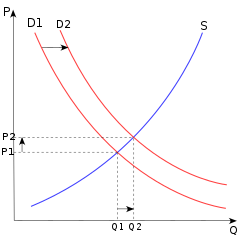Comparative statics
Comparative statics is a term from economics , more precisely from microeconomics . It is understood as the comparison of several macroeconomic equilibrium states . Only the two static equilibrium states are compared, while the transition from A to B is not modeled dynamically. In the dynamic view, the path to the new state of equilibrium is also taken into account.
Here, a start and a target state (hypothetical state) are usually compared; for example, when a tax is introduced, the effect on supply and demand as a result of the price increase could be projected. This instrument is very often used to find preferences and to use demand preferences. In contrast to static, in which time appears as a constant, and in contrast to dynamics, in time as a variable, time appears as a parameter in comparative static. A characteristic of a comparative static analysis is that it is incomplete in the sense that the adjustment process has to be explained in retrospect.
Most of the CGE (Computational General Equilibrium) models are also comparatively static models.
Web links
- Comparative statics - Article at mikrooekonomie.de
Individual evidence
- ^ Paul A. Samuelson: Foundations of Economic Analysis . Harvard University Press, 1983, pp. 8f.
literature
- Felderer, Homburg: Macroeconomics and New Macroeconomics . 7th edition.
